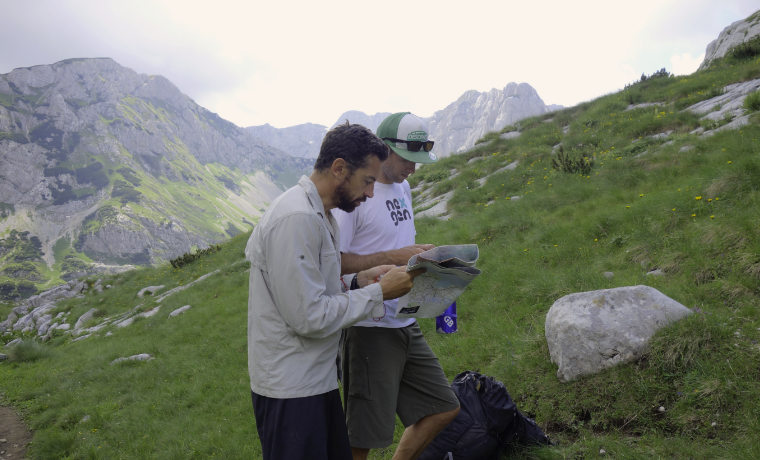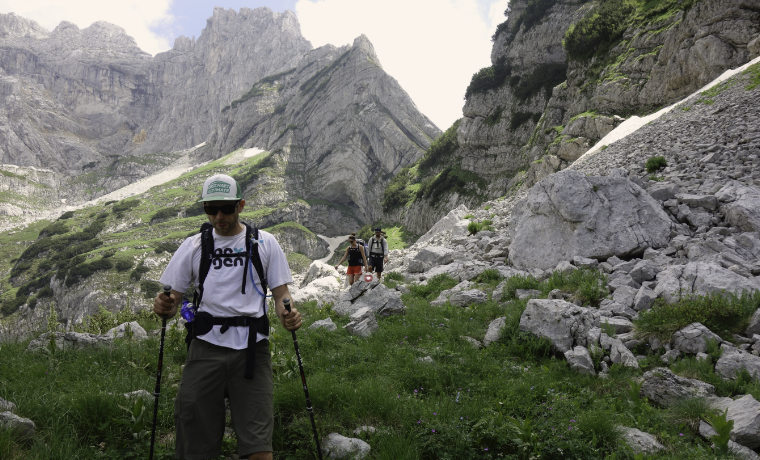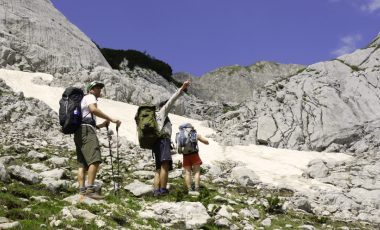Most hobbies and sports have a language all their own. It doesn’t matter if it’s cycling, climbing, paddle boarding, or skiing; the people who do these activities usually know all the terms and lingo so they can communicate with one other.
Unfortunately, those terms can often seem impenetrable to outsiders and may even sound like a foreign language!
Hiking is no different, and there are a lot of hiking terms that probably make very little sense to non-hikers.
You don’t have to be fluent in hiking terminology to enjoy a long walk in the countryside. However, a basic knowledge can be helpful if you want to gain specific information or just communicate on an equal footing with your fellow hikers. Maybe in the pub after a long day on the hills.
It’s never too late to start building or expanding your hiking vocabulary, so here are some of the most common European and North American hiking terms that every hiker should know.
Study this list of hiking lingo, familiarise yourself with it, and be ready for a test at the end!
75 essential hiking terms and trail terminology
European and North American hikers use a lot of the same hiking jargon, but not all trail terms are the same on both sides of the Atlantic. That said, for better or worse, the English language is becoming increasingly Americanised, so hikers need to be almost bilingual.
We’ll let you know if any of the following hiking slang and trail terminology is specifically European or American.
That way, you won’t embarrass yourself using American hiker lingo while tramping across Dartmoor or using British hiking trail terms in the wilds of Yosemite!
01Arête
A narrow rocky ridge with steep drops on both sides. You may need to walk along an Arête during mountainous hikes.
02Alpine start
This means starting a hike long before the sun rises. Usually done when you have a lot of miles to cover, have a deadline to meet, or want to avoid hiking in the heat of the day.
03Backcountry (US)
An Americanism for wilderness areas not ordinarily accessible by road.
04Backpacking (US)
Hiking for several days while carrying all your supplies in a rucksack. Also known as trekking.
05Baselayer
Active underwear that keeps you warm and wicks away sweat. Usually worn under a mid-layer, but can also be worn on its own during warmer weather.
06Base weight
The weight of your hiking backpack minus consumables such as food and water.
07Big three
Your three largest, most expensive, and often heaviest items of hiking gear – tent, sleeping bag, and backpack.
08Bivi bag
An abbreviation of bivouac sack. A bivi bag is a waterproof sleeping bag cover that can be used instead of a tent. Bivi bags are popular with ultra-light hikers. There are hooped varieties that are basically tiny one-person tents.
09Bladder
Something you need to empty regularly while hiking. Only joking; it’s a collapsible water bottle that is usually used in conjunction with a drinking tube so you can hydrate on the move. It’s also known as a hydration reservoir.
10Blaze (US)
Marks and signs on a trail that indicate which path to take. (US)
11Bog trotter (UK)
A hiker who really enjoys muddy walks on rough and boggy moorlands, especially in the Peak District.
12Bonk
No, not what happens on a hike when the lights go out but, instead, the feeling of being heavy-legged and very tired. Usually caused by low blood sugar. GORP or trail snacks usually cure this immediately!
13Bothy (UK)
A small, basic hut or shelter which is usually left unlocked and is free to use. Most common in Scotland and Wales.
14Brook (UK)
A stream or small river as in, “I was trying to cross that brook when I slipped and fell in.”
15 Bushwhacking
Hiking through areas of overgrown foliage. This may be necessary because you’re following a rarely used or poorly maintained trail, or you’ve gone off-route.
16Camel up (US)
The act of drinking as much water as possible to avoid having to carry more than necessary or because the next water source is some way ahead.
17Cairn
A pile of rocks used instead of or in addition to blazes to mark a trail. Most cairns are built by well-meaning hikers but also break the “leave no trace” principle.
18Cat hole (US)
A small hole in the ground in which hikers leave their poop. Ideally, a cat hole should be at least six inches/15 centimetres deep and 200 feet/75 meters from the trail and any water sources. Hikers often carry small trowels so they can dig a cat hole more easily.
19Col (UK)
A dip in between two hills or mountain peaks.
20Cold soaking
The practice of rehydrating food but not heating it to avoid carrying a stove. For example, you could put some porridge in a container with some water, dried milk, and sugar, leave it overnight to soften, and then eat it the next morning. Delicious!
21Contour
Parallel lines on a map indicating the steepness of a slope. Also, the practice of moving around a hill without losing or gaining height, which is sometimes known as traversing.
22Cowboy camping (US)
Camping out under the stars without a tent. Cowboy camping may or may not use a bivi bag.
23Cowboy coffee (US)
Coffee granules brewed in a kettle, saucepan, or billy can and not filtered. The absolute BEST type of coffee when hiking!
24Crampons
Removable spiked metal frames worn on the bottom of walking boots for grip on snow or ice.
25Day hike
A one-day hike short enough to complete in a single day.

26Daypack
A small rucksack or backpack for one-day hikes. Typically 10-25 litre capacity, so enough for your waterproofs, a snack, drink, and first-aid kit.
27DEET
Short for diethyltoluamide, which is an ingredient in most insect repellents. Essential for hiking comfort in some regions, especially Scotland, as a defence against the evil midges.
28Dry camp
Not a camp during the prohibition era but, rather, a camping area where there is no water. Generally best avoided unless you know of a water source shortly before or after so you can replenish your supplies.
29Elevation gain
The total amount of climbing on a trail or route. Typically expressed in meters (UK) or feet (US). Useful to know in advance so you can tell how hilly a trail is going to be.
30False summit
A plateau encountered before actually reaching a summit, as in “I thought this was the end of the climb, but it’s just a false summit.”
31Fastpacking
A sort of cross between hiking and trail running. Fastpackers use minimalist and ultra-light gear (UL), so they can move as quickly as possible.
32Fell walking (UK)
Hiking on the hills and mountains of England, i.e., the fells.
33Footprint
The only thing you should leave on a hike and a separate groundsheet designed to be used under your tent to protect it (and you) from sharp rocks, thistles, dirt, etc.
34Ford
A crossing point of a river or stream. Using a ford may still result in wet feet, depending on the depth of the water.
35Gaiters
Short leggings worn around the lower legs to keep water and debris out of your boots. Very useful in deep snow and areas with lots of undergrowth.
36Gear explosion
The practice of spreading your gear all over a campsite. Also known as a yard sale. Generally best avoided if you don’t want to lose your equipment.
37GORP (US)
Short for good old raisins and peanuts and better known as trail mix. A traditional high-energy snack that’s popular with hikers. GORP is cheap, readily available, easy to store, and very calorific.
38Gore-Tex
Branded name for a waterproof yet breathable material used to make jackets, trousers, and boot linings. A hiker may also say things like, “it’s starting to rain, so I’m going to put on my Gore-Tex.”
39GPS
The abbreviation for Global Positioning System, a satellite-based navigation system. Accurate within tens of meters, GPS makes navigation much easier but is not 100% reliable and should not be viewed as a replacement for map reading and being able to use a compass.
40Guylines
Thin but strong ropes used to tie down a tarp or tent. Also designed to trip you up in the middle of the night as you head out to find a quiet place to pee!
41Hangry (US)
Feeling so hungry that it’s affecting your mental state and making you feel angry. A common condition toward the end of a long day of hiking, especially if you have run out of food. May or may not be accompanied by feeling bonked.
42Hiker midnight (US)
The time that most hikers go to sleep, and typically shortly after it gets dark.
43Hiker tan (US)
The layer of dirt and dust that accumulates during a long hike. Also, those special tan lines you get when you wear a t-shirt, shorts, socks, and sunglasses for days on end in bright sunshine.
44Hut
A cabin on a trail for sleeping. These are usually very rough and ready with no real amenities but may have running water and provide shelter from the elements.
45HYOH (US)
Short for hike your own hike. This is an expression used on the big US trails, such as the Appalachian Trail. It means going at your own speed. HYOT (hike your own trail) is another similar expression.
46Knob (US)
A small, rounded hill or mountain.
47Leave no trace
The unbreakable rule of hiking – leave nothing but footprints and take nothing but pictures. Take this quiz to see how well you know the principles.
48Lean-to
A three-sided shelter normally made from a tarp, although lean-tos can also be made from other materials, such as tree branches interwoven with brush or ferns. Lean-tos are useful emergency shelters.
49Long-distance trail
A hiking trail that’s typically longer than 60 miles/100 kilometres.
50Munro (UK)
Scottish mountains.

51Murdo (UK)
More Scottish mountains
52NERO (US)
This backpacking term means a near zero day, referring to how far you’ve hiked. For example, on a long hike, you may take a planned or unplanned day off and enjoy a NERO in town to rest and relax.
54PUDs (US)
Pointless ups and downs – a very undulating section of a hiking trail.
55Rambling (UK)
A British term for hiking, especially referring to less hilly terrain, which would be called hill or fell walking.
56Rucksack
Another name for a backpack.
57Scramble
A very steep incline that may be very rough or even require you to use your hands and knees to traverse it.
58Scree (UK)
Slopes of loose rocks or pebbles that are hard to ascend but can be quite fun to descend. Scree running is a cross between downhill skiing and skateboarding, or that’s how it feels, anyway. Also known as talus (US).
59Sleeping pad/mat
A lightweight hiker’s mattress. May be made of closed-cell foam or inflatable. Never as comfortable as the advertising materials promise!
60Spork
A combination of a spoon and fork and the only cutlery a hiker really needs. Some sporks even have serrated edges, so they can be used as knives, too.
61Stealth camping
Camping at an unofficial site, also known as wild camping.
62Switch back (US)
Zigzags that are usually there to make steep ascents/descents more manageable, although they also add distance to your hike.
63Tarp
An abbreviation of tarpaulin, which is a large sheet of waterproof material that can be used to make a makeshift shelter. Some hikers carry tarps instead of tents to save weight.
64Thru-hiker (US)
Someone who does a long-distance hike in one go, as opposed to a section hiker who only hikes for a few days at a time and doesn’t complete the trail in its entirety.
65Trailhead (US)
The starting point of a hike or a section of trail, as in “I’ll be at the trailhead at 8am, so don’t be late!”
66Trail family (US)
People who you meet and then stick with during a long-distance hike.
67Trail magic (US)
The act of spreading kindness and goodwill to hikers. Non-hikers and hikers can spread trail magic, for example, by sharing food, giving a fuel canister, offering the use of a mobile phone, or similar.
People who give trail magic are called trail angels. It’s karma, man; be nice to everyone, and they’ll be nice to you.
68Trail name (US)
Long-distance hikers often give themselves or are given nicknames. Many hikers are only known by their trail names and don’t use their real names when they are hiking.
69Trekking poles
Walking sticks designed to make long-distance walking a little easier by letting you use your arms to bear some of the weight. Also known as alpine poles, hiking poles, or walking poles.
70Trig point (UK)
Also known as triangulation points. These are concrete pillars installed by Ordinance Survey for navigation purposes. Usually placed on high ground and visible from far away. Trig points are marked on most British maps.
71Ultra-light
UL for short, ultra-light hikers carry as little gear as possible, and what they do have is very light. Carbon fibre and titanium are common materials of choice for ultra-light hikers.
72Vestibule
The porch of your tent. An ideal place to store your backpack, damp boots and carefully cook your food if the weather is bad.
73Wainwright (UK)
The hills and mountains of the Lake District
74Widowmaker
A dead tree branch that could fall on your tent or bivi to cause serious injury. It’s always best to avoid pitching your tent beneath potential widowmakers, especially when it’s windy.
74Yomp
Originally a military abbreviation for “Your Own Pace March.” Now more likely to be used to describe a fast, challenging hike as in, “we really had to yomp to reach the campsite before dark.”
01Zero day (US)
Not just a NERO day but a day during which you don’t walk at all. Just rest, relax, eat, and sleep – no hiking today!
Hiking terms and lingo – wrapping up
Okay, so we lied about there being a test at the end of this article. Even so, you should now be able to communicate more efficiently with your fellow hikers and be comfortable with a wide range of hiking terms.
So, the next time you’re asked if you’ve got some GORP, fancy a cowboy coffee or know where the trailhead is, instead of being perplexed, you’ll be able to answer like a pro.



